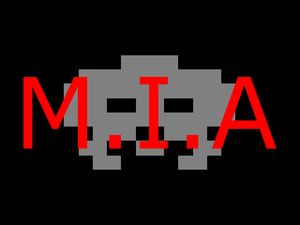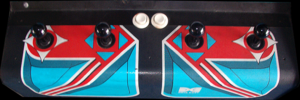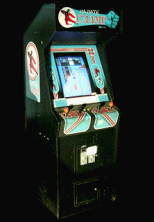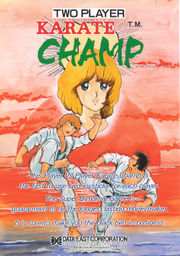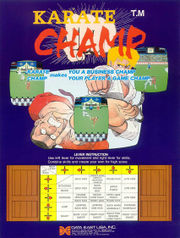Lost In Translation/Karate Champ
| Karate Champ | |
|---|---|
| Manufacturer | Data East USA |
| Released | 1984 |
| Control Method |
(2x) 4-way Joystick |
| Main CPU | (3x) Z80 (@ 3.000 MHz) Z80 (@ 3.000 MHz) |
| Sound CPU | Mono (2x) AY-3-8910A (@ 1.500 MHz) DAC |
| Video Details |
Raster (Vertical) 256 x 224 pixels 60.00 Hz 256 Palette colours |
| Screens | 1 |
| ROM Info | 30 ROMs 221,952 bytes (216.75 KiB) |
| MAME ID | kchamp · karatedo · karatevs · kchampvs |
About The Game
Karate Champ is a seminal 1-on-1 fighting game set over the course of a karate tournament and utilised a somewhat awkward dual joystick control system, with simulataneous joystick manipulation required to execute even the simplest of kicks.
Trivia
Released in September 1984.
This is arguably where an entire genre began; the 1-on-1 fighting game. The list of titles Karate Champ would go on to inspire is near-endless - needless to say, without this game, "Street Fighter", and countless others like it, might never have happened. The only description that can truly do this game justice is seminal.
George Weller holds the official record for this game with 239,900 points on March 2, 2002.
A Karate Champ machine was shown at the 2003 classic arcade games show 'California Extreme' in San Jose, California.
The versus version (See 'Update' section for more info) of the game can be seen in the film "Bloodsport" (1988).
This game is known in Japan as "Karate Dou", the Vs version is known in Japan as "Taisen Karate Dou - Seishun Bishoujo Hen".
Updates
The US 'Versus' (2-player) version shipped one month later in October 1984. The Versus version, however, differs slightly from its single-player sibling. There is a greater variation in backgrounds, for example, with a variety of outdoor locations as opposed to the standard Martial Art dojos of the earlier version. The sound effects also seem to be a little 'sharper', with the speech, in particular, much improved.
Cabinet and Artwork
Ports
- Consoles
- Nintendo Famicom (1986)
- Nintendo Famicom Disk (1986)
- Computers
- Tandy Color Computer (1985, "Karate")
- Commodore C64 (1985)
- Commodore Amiga (1987) (?)



